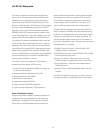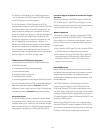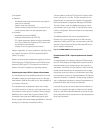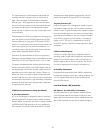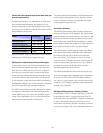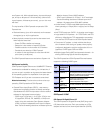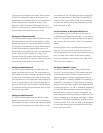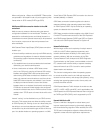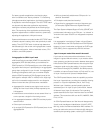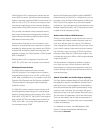
onto System z10. With reduced latency, improved through-
put, and up to 96 ports of LAN connectivity, (when all are
4-port features, 24 features per server), you can “do more
with less.”
The key benefi ts of OSA-Express3 compared to OSA-
Express2 are:
• Reduced latency (up to 45% reduction) and increased
throughput (up to 4x) for applications
• More physical connectivity to service the network and
fewer required resources:
– Fewer CHPIDs to defi ne and manage
– Reduction in the number of required I/O slots
– Possible reduction in the number of I/O drawers
– Double the port density of OSA-Express2
– A solution to the requirement for more than 48 LAN
ports (now up to 96 ports)
The OSA-Express3 features are exclusive to System z10.
OSA-Express2 availability
OSA-Express2 Gigabit Ethernet and 1000BASE-T Ethernet
continue to be available for ordering, for a limited time, if
you are not yet in a position to migrate to the latest release
of the operating system for exploitation of two ports per
PCI-E adapter and if you are not resource-constrained.
Historical summary: Functions that continue to be sup-
ported by OSA-Express3 and OSA-Express2
• Queued Direct Input/Output (QDIO) – uses memory
queues and a signaling protocol to directly exchange
data between the OSA microprocessor and the network
software for high-speed communication.
– QDIO Layer 2 (Link layer) – for IP (IPv4, IPv6) or non-
IP (AppleTalk, DECnet, IPX, NetBIOS, or SNA) work-
loads. Using this mode the Open Systems Adapter
(OSA) is protocol-independent and Layer-3 indepen-
dent. Packet forwarding decisions are based upon the
Medium Access Control (MAC) address.
– QDIO Layer 3 (Network or IP layer) – for IP workloads.
Packet forwarding decisions are based upon the IP
address. All guests share OSA’s MAC address.
• Jumbo frames in QDIO mode (8992 byte frame size)
when operating at 1 Gbps (fi ber or copper) and 10 Gbps
(fi ber).
• 640 TCP/IP stacks per CHPID – for hosting more images.
• Large send for IPv4 packets – for TCP/IP traffi c and CPU
effi ciency, offl oading the TCP segmentation processing
from the host TCP/IP stack to the OSA-Express feature.
• Concurrent LIC update – to help minimize the disrup-
tion of network traffi c during an update; when properly
confi gured, designed to avoid a confi guration off or on
(applies to CHPID types OSD and OSN).
• Multiple Image Facility (MIF) and spanned channels – for
sharing OSA among logical channel subsystems
The OSA-Express3 and OSA-Express2 Ethernet features
support the following CHPID types
:
CHPID OSA-Express3, Purpose/Traffi c
Type OSA-Express2
Features
OSC 1000BASE-T OSA-Integrated Console Controller (OSA-ICC)
TN3270E, non-SNA DFT, IPL to CPC and LPARs
Operating system console operations
OSD
1000BASE-T
Queued Direct Input/Output (QDIO)
GbE TCP/IP traffi c when Layer 3
10 GbE Protocol-independent when Layer 2
OSE 1000BASE-T Non-QDIO, SNA/APPN
®
/HPR and/or TCP/IP
passthru (LCS)
OSN 1000BASE-T OSA for NCP
GbE Supports channel data link control (CDLC)
OSA-Express3 10 GbE
OSA-Express3 10 Gigabit Ethernet LR
The OSA-Express3 10 Gigabit Ethernet (GbE) long reach
(LR) feature has two ports. Each port resides on a PCIe
adapter and has its own channel path identifi er (CHPID).
26



